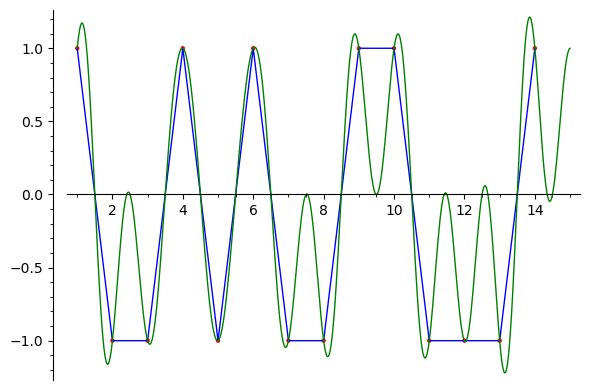The Liouville function in number theory is defined as:
$$\lambda(n) := (-1)^{\Omega(n)} \text{ where } \Omega(n) := \sum_{p|n} v_p(n)$$
Taking the discrete time Fourier transform and then taking the inverse, I arrived at the following function for $\lambda$ extended to $\mathbb{R}$ or $\mathbb{C}$:
$$\lambda(x) = \sum_{z \in \mathbb{Z}} \frac{\cos(\pi(\Omega(z)+x-z))\sin(\pi(x-z))}{\pi(x-z)}$$
where if $x$ is an integer $a$ the limit for $x \rightarrow a$ gives $\lambda(a) = (-1)^{\Omega(a)}$. Here is an image where red points correspond to $(n,\lambda(n))$ and blue lines correspond to $\lambda(n)$ whereas the green function corresponds to the extended function $\lambda(x)$:
This can also be written as:
$$\lambda(x) = \frac{\cos(\pi x)\sin(\pi x)}{\pi}\gamma(x)$$
where $\gamma(x)$ is defined as:
$$\gamma(x) = \sum_{z \in \mathbb{Z}} \frac{(-1)^{\Omega(z)}}{x-z}$$ $$=\frac{1}{x}+2x\sum_{n=1}^{\infty} \frac{(-1)^{\Omega(n)}}{x^2-n^2}$$
I tried to search for "extension of Liouville function" or "liouville function" "fourier transform" but could not find anything similar to this representations.
Q1) Is the function $\gamma(x)$ something known or can it be transformed to something more familiar (It looks a little bit like the Weierstraß elliptic function but I am not sure what this means)?
Q2) Is there a differential equation which is satisfied by the $\lambda$ function or the $\gamma$ function?
For Q2), we have the following differential equation:
$$(\frac{\lambda(x)}{\gamma(x)})'' = -4 \pi^2 \frac{\lambda(x)}{\gamma(x)}$$
but this is not really useful, since we have two rather unknown functions popping up in the differential equation. It would be nice, if it is possible to give a differential equation where only terms of one function appear.
As a side note, if it is of interest:
Using the known Dirichlet series of $(-1)^{\Omega(n)}$ one can derive for $0 < |x| < 1$ the following series:
$$\gamma(x) = \frac{1}{x} - 2 \sum_{n=0}^{\infty} \frac{\zeta(4(n+1))}{\zeta(2(n+1))}x^{2n+1}$$
Here is a plot of the gamma function in the complex numbers:
Thanks for your help.
Edit: Here is the Sagemath code to do the example computations which shows that in both cases for $x=0$ we have $\lambda(x)=1$.
Application:
Denote with $\beta(x) = \sum_{n=1}^{\infty} \frac{(-1)^{\Omega(n)}}{x^2-n^2}$, so that $\gamma(x) = 1/x+2x\beta(x)$.
Then we have the following functional equation:
$$\forall a,b \in \mathbb{Z}: \lambda(a+b) = \lambda(a) \lim_{x\rightarrow a}\frac{\gamma(x+b)}{\gamma(x)}$$
From this one deduces:
1)
$$\forall n \in \mathbb{Z}: \lambda(n+1) = \lambda(n) \lim_{x\rightarrow n}\frac{\gamma(x+1)}{\gamma(x)}$$
2)
$$\forall a,b \in \mathbb{Z}: \lambda(ab) = \lim_{x\rightarrow a+b}\frac{\gamma(x)^2}{\gamma(x-a)\gamma(x-b)}$$
3)
Then for a normalized polynomial $P(x) = \prod_{i} (x-\alpha_i)$ with integer roots $\alpha_i$ we get as an application, where $\Lambda = $ denotes the set of roots:
$$\forall x \in \mathbb{Z}, x \notin \Lambda:$$
$$\lambda(P(x)) = \lim_{t \rightarrow x} \frac{\lambda(t)^{\operatorname{deg}(P)}}{(1/t+2t\beta(t))^{\operatorname{deg}(P)}}\prod_{\alpha \in \Lambda} (1/(t-\alpha)+2(t-\alpha)\beta(t-\alpha))$$




